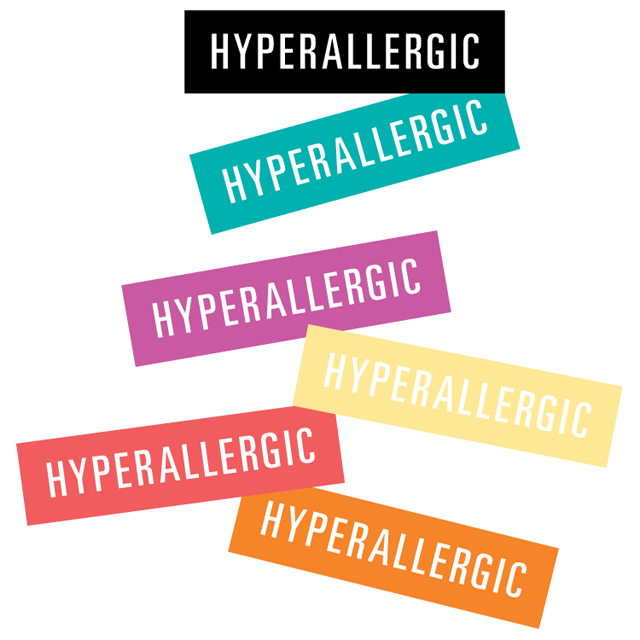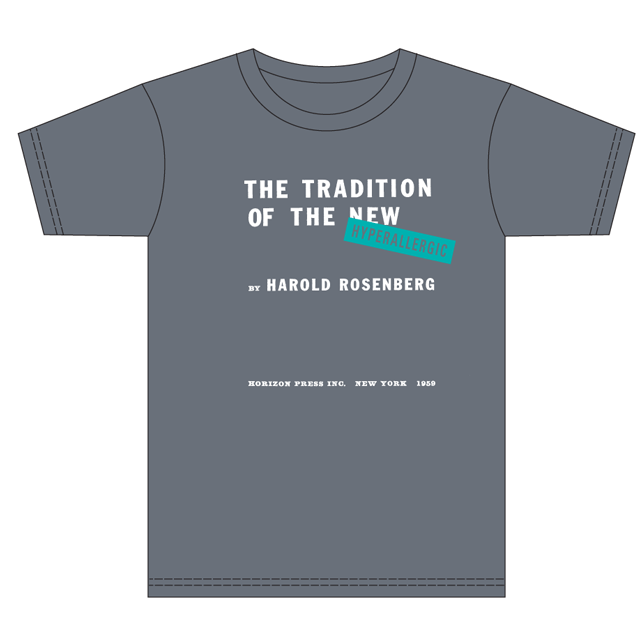Introducing the Hyperallergic Art Library T-shirts
Today is the day! Hyperallergic has launched the first edition of our Art Library series with five titles by some of the innovators of art writing.

Today IS the day! Hyperallergic has launched the first edition of our Art Library series with five titles by some of the innovators of art writing.
The brainchild of Peter Rentz, a New York-based graphic designer and art director, the series was conceived “to engage the Hyperallergic editors in the design process as well as help show what books/text have influenced their point of view.”
The typographic frontispieces of five important English-language first editions are presented on these t-shirts along with a slap tag of Hyperallergic. Yes, we’ve appropriated them. Yes, we’re happy about it. And yes, we love ALL these books.
Available for only $25 (plus shipping/handling), these are our tribute to art lit.

Johann Joachim Winckelmann‘s first English translation of his writings, including his masterpiece Geschichte der Kunst des Alterthums (“The History of Art in Antiquity”), which was published in 1764, kicks off this series.
Long understood to be gay (at least as gay as an 18th C. librarian of the Vatican library could be, which is pretty gay) Winckelmann was openly in same-sex relationships during his life in Rome. His life was cut short when he was murdered in a hotel room on his way from Vienna to Rome … some say trick gone bad, others say it was a simple robbery. Either way it makes for an interesting — if tragic — story.
The first English (and French) translations of Winckelmann’s works were done by Swiss/British painter Henry Fuseli. [BUY]

Walter Pater‘s Studies in the History of the Renaissance (1873) was a hugely important book even if it is largely unknown to art worlders nowadays. It contained the first essay on Renaissance painter Sandro Botticelli ever written in English, a famous line that suggests that “All art constantly aspires towards the condition of music” and a description of the Mona Lisa that enchanted the Victorian world:
“She is older than the rocks among which she sits; like the vampire, she has been dead many times, and learned the secrets of the grave; and has been a diver in deep seas, and keeps their fallen day about her; and trafficked for strange webs with Eastern merchants, and, as Leda, was the mother of Helen of Troy, and, as Saint Anne, the mother of Mary; and all this has been to her but as the sound of lyres and flutes, and lives only in the delicacy with which it has molded the changing lineaments, and tinged the eyelids and the hands.”
His critics said that this book encouraged “hedonism” — like that’s a bad thing. But his supporters, who are much more fabulous than his critics could ever be, looked up to him and his ideas, which in turn influenced the Aesthetic Movement of the 19th C.
Oscar Wilde paid tribute to Pater in “The Critic as Artist” (1891) and Pater’s influence can also be seen in the work of art historians and early Modernists, including Bernard Berenson, Roger Fry, Kenneth Clark, Marcel Proust, James Joyce, W. B. Yeats and Ezra Pound. [BUY]

Sigmund Freud‘s Leonardo da Vinci originally appeared in German, of course, but A.A. Brill’s English translation appeared soon after in 1915.
Ok, we all know this work by Freud is flawed but it’s still a beautiful work of creative non-fiction (fiction?). What did Freud get wrong? A lot of things, but this is the most notable:
Unfortunately for Freud, the word “vulture” was a mistranslation by the German translator of the Codex and the bird that Leonardo imagined was in fact a kite, a bird of prey which is occasionally a scavenger. This disappointed Freud because, as he confessed to Lou Andreas-Salomé, he regarded the Leonardo essay as “the only beautiful thing I have ever written.”
[BUY]

Harold Rosenberg was one of the two giants of American art criticism in the middle of the 20th C. Rosenberg’s The Tradition of the New (1959) is a must-read for any lover of Abstract Expressionism — he called it “Action Painting” — and it was published the same year British critic Herbert Read labeled Rosenberg as “the Apollinaire of Action Painting.”
It should be noted that The Tradition of the New doesn’t only concern itself with visual art and it easily embraces poetry, politics and pop culture to give a whole picture of the culture industry of the period.
One of the most beautiful elements of this book is its title. New, by then, had become part and parcel of the marketing of America itself. [BUY]

Rosalind Krauss‘s The Originality of the Avant-Garde and Other Modernist Myths (1985) is the book people either love or love to hate — and always for different reasons.
While Krauss’s work has a special place in the heart of sculptors, her thinking about art is always engaging and seems to come from a deep love of art. [BUY]
* * *
All the t-shirts can be purchased at the Hyperallergic Store.





